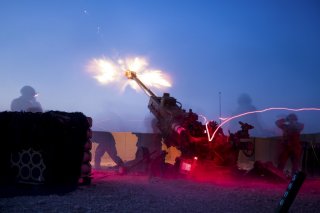How the Army Can Drop Lots of 'Lead' on the Enemy (Think Satellites)
The Army isn’t alone in attempting to use GPS and other satellite technology to hit targets at a greater distance.
Hitting a target beyond the line of sight has never been without difficulty when it comes to artillery shelling. This indirect fire has typically been performed by calculating azimuth and inclination but correcting such shots can be almost impossible if there is no way to properly determine where the shells are landing.
During World War I, the German army employed one of the largest cannons ever to bombard Paris. But because it was nearly impossible to aim and it took so long to load, the weapon proved largely ineffective.
More than one hundred years later, the U.S. Army has begun to pair space-based sensors with artillery units that could allow howitzer and rocket gunners to be able to detect, identify, process and engage enemy units faster than ever. According to recent reports from C4ISRNET, the Futures Command’s cross-functional team in charge of Assured Position, Navigation and Timing conducted the first such tests on three occasions earlier this year.
During the exercises, the service was able to link space sensors with shooters in live-fire demonstrations in Grafenwoehr, Germany. A spokesperson from the Army said the team “successfully sensed and hit targets at ranges beyond line of sight using satellite capabilities that have not been accessible to ground forces until now.”
According to a report from Popular Mechanics the recent tests involved Army M777 155-millimeter howitzers and M270 Multiple Launch Rocket Systems, which were able to access the satellite sensors and use the data to engage notional targets. Both the howitzers and rocket shells utilized precision-guided shells to hit their respective targets.
The exercise was also able to highlight the Army's ability to engage defeat “time-sensitive targets” quickly while the artillery was able to conduct far more accurate fire missions on the battlefield. What is notable about these efforts is that the sensors and shooters have never worked together before. The Army's Long-Range Precision Fires Cross-Functional Team was founded in 2018 as part of the Army Futures Command and its top priority had been to develop long-range precision fires that could eventually exceed ten thousand nautical miles.
This is just the latest U.S. Army effort to hit targets so accurately beyond the line of sight. A test was conducted at the Yuma Proving Grounds in Arizona with the XM1299 prototype Extended Range Cannon Artillery (ERCA), which fired from forty miles away and came down just meets from the intended target. The shells tested included a boosted version of the GPS-guided M982 Excalibur precision-strike shell as well as the new experimental XM1113 Rocket-Assisted Projectile.
The Army isn’t alone in attempting to use GPS and other satellite technology to hit targets at a greater distance. The U.S. Navy has been seeking longer-range precision weapons for its deck-mounted five-inch guns to better destroy enemy targets. Among the options considered was a Raytheon-developed GPS-guided Excalibur N5 round, which could pinpoint targets out to about twenty-six nautical miles.
What should worry U.S. military planners is that potential adversaries have also been exploring ways to better pinpoint targets from ever great distances. This month, Russia Beyond reported that the Russian Armed Forces received its first shipment of upgraded Russian artillery systems—the ‘Koalitsiya-SV,’ a self-propelled artillery system that utilizes artificial intelligence to target at distances of up to 70 kilometers or 43.5 miles.
“The deviation radius of the Koalitsiya is about one-two meters,” Professor Vadim Kozyulin of the Russian Academy of Military Science told the news outlet. “Operating at a 70 kilometers range, the weapon resembles a sniper rifle. Just as precise and deadly.”
Peter Suciu is a Michigan-based writer who has contributed to more than four dozen magazines, newspapers and websites. He is the author of several books on military headgear including A Gallery of Military Headdress, which is available on Amazon.com.
Image: Flickr / U.S. Army

